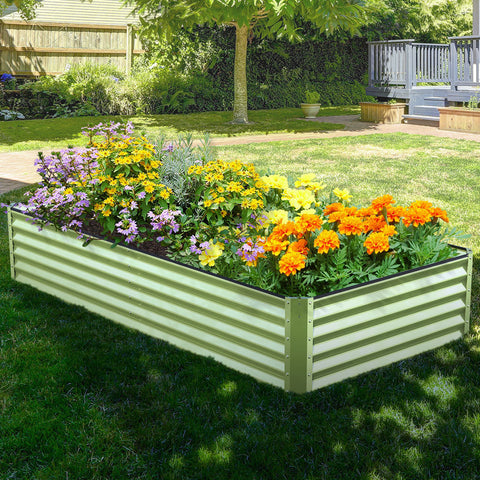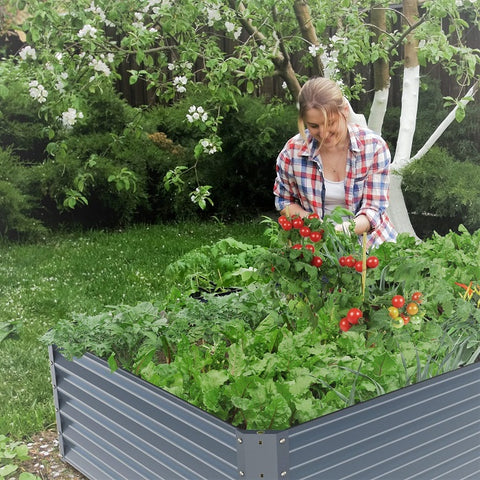Planting vegetables at home is a cost-effective method, and you can also get up close to nature. Planting tomatoes and other favorite vegetables or herbs with seeds can save you more money. You will also find that the taste and texture of agricultural products grown in the garden are even better than what you find in the grocery store. Also, taking care of your vegetable garden can be considered exercise! Study these techniques and tips in depth to get your garden off to a good start. The following content also has some reference value for raised garden beds.
- Starting from a small space
If you are a novice gardener, start small. Instead of feeling frustrated by the time investment required for a large garden, it's better to be excited about what you produce in a small garden. Before investing a lot of time and money in this new hobby, it is best to first learn some basic knowledge of gardening. You will feel how much time gardening has taken. You will find out if you enjoy spending time outdoors planting, watering, and weeding. You will also learn how many agricultural products you and your family can eat in a summer.
Choose up to five types of vegetable cultivation, with each type planting some. You will get enough fresh agricultural products to make your summer meal, and it's easy to keep up with household chores. Planting vegetables in containers is also a great way to start.

- Plant what you like to eat
What would you like to eat? Your answer will tell you what to plant in the garden.
Each vegetable has its own characteristics. Some plants produced are smaller and ideal for containers or small gardens. Other varieties have better disease resistance, higher yields, or better heat or cold resistance. Start by selecting the vegetables you like to eat, and then study their size and care needs.
Think about how much you and your family will eat, and how likely you are to freeze, canned, or give away excess agricultural products. Then realistically consider how many seeds or plants you need to plant in the field. Many beginners have made the mistake of planting too much. Vegetables such as tomatoes, chili peppers, and pumpkins are available throughout the season, so you may not need many plants to meet your needs. Other vegetables, such as carrots, radishes, and corn, can only be harvested once and then need to be replanted.
Continuous crop
Planting vegetables with cool and warm weather will allow you to continuously harvest vegetables and herbs in spring, summer, and autumn. After harvesting cool weather crops, plant your favorite hot weather crops such as tomatoes, chili peppers, eggplants, and vanilla. In autumn, you can harvest potatoes, cabbage, and kale.
- Choose a location for your garden
No matter where you place your garden or decide what to plant, your location needs to meet two basic requirements to achieve maximum success: water and light.
Adequate sunlight is necessary

Like all plants, vegetables require sunlight to initiate photosynthesis. The fastest growing vegetables require at least 6 to 8 hours of direct sunlight per day, without being obstructed by trees, shrubs, or fences.
If your yard has some shade, plant vegetables and herbs that can tolerate these conditions, such as lettuce, kale, beets, spinach, scallions, coriander, parsley, and thyme. If your website has at least 4 hours of direct sunlight per day, root vegetables such as carrots, radishes, and beets may also be effective. Alternatively, if you have a sunny terrace, switch to container gardening. In this way, you can place vegetables and herbs that enjoy sunlight, such as tomatoes, cucumbers, beans, basil, dill, and rosemary, in good places.
Reflections on Convenient Water Use
The closer your land is to the water source, the better. In the first few weeks after seed germination or seedling transplantation, you need to be able to water regularly to help these fragile plants produce strong roots and stems. Once your plants are established, it's best to give your garden a drink every few days instead of sprinkling a little every day. Then, the water will enter the soil deeper, which will encourage the roots to grow deeper, where they can better obtain the nutrients needed to maintain health. Consider installing soaking rooms or regular drip irrigation to help minimize water waste and the time required for watering.
- Planting in fertile soil
In order to achieve the best harvest, your garden needs the best soil you can give it. When you feel the soil is rich and healthy, you will know that it is easy to excavate and has good drainage. Pick up a trowel and put it in your hand. Do you feel any gravel? There is too much sand. Is it powdery? There is too much mud. Does it stick when it's wet? There is too much clay. The combination of these three types and their specific proportions determine the texture of your garden soil. This texture will affect drainage and nutrient supply.
The soil you want is dark, fragile, and full of vitality. Fortunately, regardless of the texture, over time, all soils can be improved by adding organic matter. Take sandy soil as an example. They are composed of large soil particles, so the speed of water and nutrients passing through the gaps is relatively fast. Adding organic matter (usually compost) to sandy soil helps fill the space between sand particles, which helps retain water and nutrients for plants.
In order to prepare the soil for planting, you can sprinkle any necessary conditioner, such as compost, and use a tiller or shovel to put it into the soil. Avoid stepping on freshly cultivated soil, otherwise you will compact it and waste your hard work. Then rake the surface flat and thoroughly water it. Rest the bed for a few days before planting, so that the soil conditioner can work.
If the soil is poor, a raised garden bed is a simple choice. Build a raised bed on the existing lawn by lining the bottom of the frame with several layers of newspaper and then filling it with soil. This way, you don't have to do so much digging work.
- Prepare for pests and diseases
Some problems require special solutions, but overall, follow these guidelines to keep pests away from your vegetables.
Preventing the spread of weeds
Weeds compete with your vegetables for light, water, and nutrients, so it is important to keep them to a minimum. Covering with clean straw or compost can block weeds around larger plants such as tomatoes. Use a hoe to stop any sudden emergence of weed seedlings.

Prohibit animals from entering
Large pests such as deer and rabbits can cause serious damage to edible gardens. It needs an 8-foot high fence to prevent deer from jumping into the garden. The fence needs to extend 6 inches below the soil to prevent rabbits and other burrowing animals from digging.
Deterrent destructive insects
Removing large insects and caterpillars by hand and placing them in a bucket of soapy water is a safe and effective way to deal with limited pest infestation. For larger numbers of insects, try the insecticide soap spray found in most garden centers. No matter which pest control chemical you use, you must carefully follow the manufacturer's instructions.









